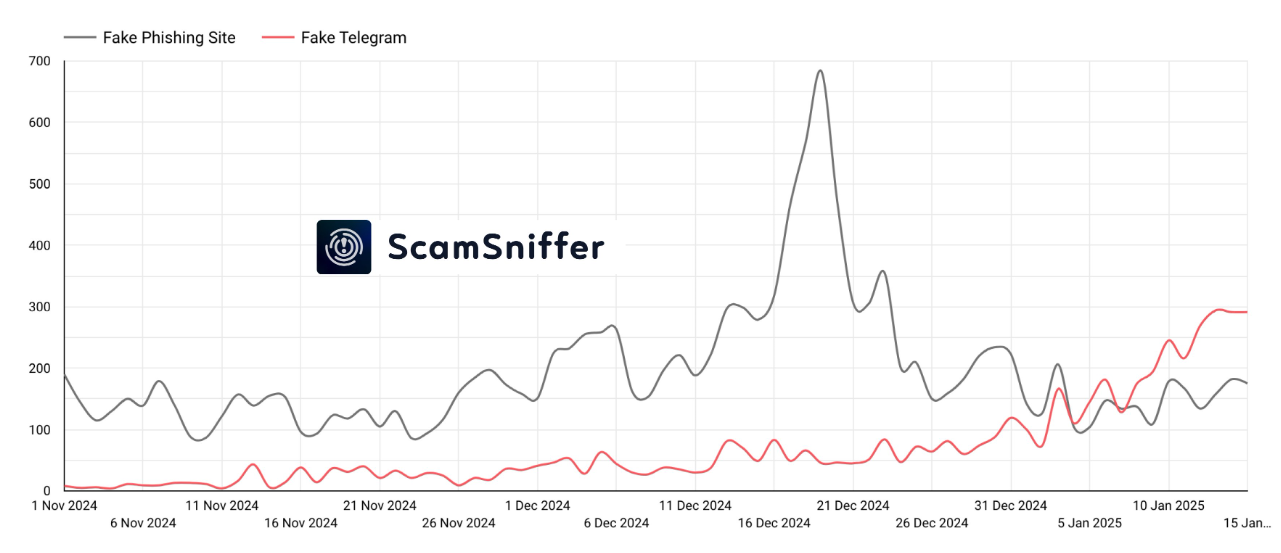| COINOTAG recommends • Exchange signup |
| 💹 Trade with pro tools |
| Fast execution, robust charts, clean risk controls. |
| 👉 Open account → |
| COINOTAG recommends • Exchange signup |
| 🚀 Smooth orders, clear control |
| Advanced order types and market depth in one view. |
| 👉 Create account → |
| COINOTAG recommends • Exchange signup |
| 📈 Clarity in volatile markets |
| Plan entries & exits, manage positions with discipline. |
| 👉 Sign up → |
| COINOTAG recommends • Exchange signup |
| ⚡ Speed, depth, reliability |
| Execute confidently when timing matters. |
| 👉 Open account → |
| COINOTAG recommends • Exchange signup |
| 🧭 A focused workflow for traders |
| Alerts, watchlists, and a repeatable process. |
| 👉 Get started → |
| COINOTAG recommends • Exchange signup |
| ✅ Data‑driven decisions |
| Focus on process—not noise. |
| 👉 Sign up → |
-
The rise of cryptocurrency phishing scams on Telegram is alarming, with a reported surge of over 2,000% since November 2024, indicating a significant shift in online fraud tactics.
-
This dramatic increase in scams underscores the sophisticated methods employed by cybercriminals, posing unprecedented risks to the cryptocurrency community.
-
According to Scam Sniffer, “No legitimate crypto service will ever ask you to execute commands or install verification software,” highlighting the tactics used by scammers.
This article discusses the alarming rise of crypto phishing scams on Telegram, including a 2,000% increase and evolving tactics threatening user security.
Telegram Crypto Phishing Scams On The Rise
Data from Scam Sniffer paints a concerning picture as Telegram scams have now surpassed traditional phishing methods in prevalence. While overall phishing rates have stabilized, the rise of malicious Telegram group scams exposes users to significant new risks in the crypto landscape.

The graphic above illustrates the growing prevalence of Telegram-based scams compared to traditional phishing, highlighting the changing landscape of online threats.
| COINOTAG recommends • Professional traders group |
| 💎 Join a professional trading community |
| Work with senior traders, research‑backed setups, and risk‑first frameworks. |
| 👉 Join the group → |
| COINOTAG recommends • Professional traders group |
| 📊 Transparent performance, real process |
| Spot strategies with documented months of triple‑digit runs during strong trends; futures plans use defined R:R and sizing. |
| 👉 Get access → |
| COINOTAG recommends • Professional traders group |
| 🧭 Research → Plan → Execute |
| Daily levels, watchlists, and post‑trade reviews to build consistency. |
| 👉 Join now → |
| COINOTAG recommends • Professional traders group |
| 🛡️ Risk comes first |
| Sizing methods, invalidation rules, and R‑multiples baked into every plan. |
| 👉 Start today → |
| COINOTAG recommends • Professional traders group |
| 🧠 Learn the “why” behind each trade |
| Live breakdowns, playbooks, and framework‑first education. |
| 👉 Join the group → |
| COINOTAG recommends • Professional traders group |
| 🚀 Insider • APEX • INNER CIRCLE |
| Choose the depth you need—tools, coaching, and member rooms. |
| 👉 Explore tiers → |
The insights shared by Scam Sniffer indicate that these scams are more sophisticated than conventional phishing tactics. Unlike the typical “connect wallet” schemes, they employ methods including:
- Fake Verification Bots: These masquerade as security tools, enticing users to execute harmful commands.
- Fraudulent Trading and Airdrop Groups: They promise exclusive investment opportunities and free cryptocurrency to lure victims.
- “Exclusive” Alpha Groups: Scammers impersonate crypto influencers, creating a sense of urgency to manipulate potential victims.
Victims engaging with these scams risk exposing sensitive data, including passwords and wallet information, that can be exploited for cryptocurrency theft. This evolution in scam tactics raises alarming concerns, particularly as users become more aware of conventional phishing threats.
| COINOTAG recommends • Exchange signup |
| 📈 Clear interface, precise orders |
| Sharp entries & exits with actionable alerts. |
| 👉 Create free account → |
| COINOTAG recommends • Exchange signup |
| 🧠 Smarter tools. Better decisions. |
| Depth analytics and risk features in one view. |
| 👉 Sign up → |
| COINOTAG recommends • Exchange signup |
| 🎯 Take control of entries & exits |
| Set alerts, define stops, execute consistently. |
| 👉 Open account → |
| COINOTAG recommends • Exchange signup |
| 🛠️ From idea to execution |
| Turn setups into plans with practical order types. |
| 👉 Join now → |
| COINOTAG recommends • Exchange signup |
| 📋 Trade your plan |
| Watchlists and routing that support focus. |
| 👉 Get started → |
| COINOTAG recommends • Exchange signup |
| 📊 Precision without the noise |
| Data‑first workflows for active traders. |
| 👉 Sign up → |
Scam Sniffer’s recommendation is clear: avoid executing unknown scripts or commands from doubtful sources, and do not install unverified software promoted in Telegram groups.
“No legitimate crypto service will ever ask you to execute commands, install verification software, or run scripts from your clipboard,” Scam Sniffer firmly noted.
| COINOTAG recommends • Traders club |
| ⚡ Futures with discipline |
| Defined R:R, pre‑set invalidation, execution checklists. |
| 👉 Join the club → |
| COINOTAG recommends • Traders club |
| 🎯 Spot strategies that compound |
| Momentum & accumulation frameworks managed with clear risk. |
| 👉 Get access → |
| COINOTAG recommends • Traders club |
| 🏛️ APEX tier for serious traders |
| Deep dives, analyst Q&A, and accountability sprints. |
| 👉 Explore APEX → |
| COINOTAG recommends • Traders club |
| 📈 Real‑time market structure |
| Key levels, liquidity zones, and actionable context. |
| 👉 Join now → |
| COINOTAG recommends • Traders club |
| 🔔 Smart alerts, not noise |
| Context‑rich notifications tied to plans and risk—never hype. |
| 👉 Get access → |
| COINOTAG recommends • Traders club |
| 🤝 Peer review & coaching |
| Hands‑on feedback that sharpens execution and risk control. |
| 👉 Join the club → |
The platform further emphasizes the importance of utilizing hardware wallets, which safeguard private keys by keeping them offline and out of reach from potential attackers.
Telegram’s Role Under Scrutiny
The correlation between the increase in Telegram malware scams and other notable fraud trends within the crypto realm is hard to ignore. Security firms are currently identifying numerous Telegram channels actively promoting fraudulent activity, revealing serious vulnerabilities within the platform.
Impersonation of renowned crypto influencers by scam artists has also become prevalent, encouraging users to join “exclusive” groups. A recent report from Scam Sniffer documented severe implications related to fake verification bots installed by scammers, including the injection of harmful PowerShell code.
“New sophisticated scams are targeting crypto users through fake Telegram groups. Attackers impersonate multiple crypto influencers while deploying malicious bots for verification,” Scam Sniffer disclosed.
| COINOTAG recommends • Exchange signup |
| 📈 Clear control for futures |
| Sizing, stops, and scenario planning tools. |
| 👉 Open futures account → |
| COINOTAG recommends • Exchange signup |
| 🧩 Structure your futures trades |
| Define entries & exits with advanced orders. |
| 👉 Sign up → |
| COINOTAG recommends • Exchange signup |
| 🛡️ Control volatility |
| Automate alerts and manage positions with discipline. |
| 👉 Get started → |
| COINOTAG recommends • Exchange signup |
| ⚙️ Execution you can rely on |
| Fast routing and meaningful depth insights. |
| 👉 Create account → |
| COINOTAG recommends • Exchange signup |
| 📒 Plan. Execute. Review. |
| Frameworks for consistent decision‑making. |
| 👉 Join now → |
| COINOTAG recommends • Exchange signup |
| 🧩 Choose clarity over complexity |
| Actionable, pro‑grade tools—no fluff. |
| 👉 Open account → |
Criticism toward Telegram regarding its management of crypto scams is mounting. The platform faced temporary suspension in Spain due to rising complaints regarding its role in facilitating scams and piracy. Recent user frustrations echoed on social media over Telegram’s apparent lack of action against such illegal activities only amplify these valid concerns.
Amidst increased scrutiny, Telegram’s CEO Pavel Durov found himself in legal troubles in France, accused of enabling illegal transactions linked with organized crime through the platform. Authorities cautioned Durov about potential personal liability due to the absence of adequate measures against ongoing scams.
| COINOTAG recommends • Members‑only research |
| 📌 Curated setups, clearly explained |
| Entry, invalidation, targets, and R:R defined before execution. |
| 👉 Get access → |
| COINOTAG recommends • Members‑only research |
| 🧠 Data‑led decision making |
| Technical + flow + context synthesized into actionable plans. |
| 👉 Join now → |
| COINOTAG recommends • Members‑only research |
| 🧱 Consistency over hype |
| Repeatable rules, realistic expectations, and a calmer mindset. |
| 👉 Get access → |
| COINOTAG recommends • Members‑only research |
| 🕒 Patience is an edge |
| Wait for confirmation and manage risk with checklists. |
| 👉 Join now → |
| COINOTAG recommends • Members‑only research |
| 💼 Professional mentorship |
| Guidance from seasoned traders and structured feedback loops. |
| 👉 Get access → |
| COINOTAG recommends • Members‑only research |
| 🧮 Track • Review • Improve |
| Documented PnL tracking and post‑mortems to accelerate learning. |
| 👉 Join now → |
Despite international discussions and regulatory measures, Telegram malware scams show no sign of receding, indicating that users must exercise heightened vigilance. With the platform under greater scrutiny and scams on the rise, vigilance among crypto users has never been more critical.
Conclusion
The stark rise in Telegram phishing scams presents a clear call to action for cryptocurrency users. It is essential to remain cautious and informed about the evolving schemes threatening their digital assets. As the situation progresses, adhering to best practices—for instance, utilizing hardware wallets and engaging with only verified services—can mitigate risks. The growing complexity of scams necessitates ongoing awareness and education in safeguarding one’s cryptocurrency investments.
| COINOTAG recommends • Exchange signup |
| 🎯 Focus on process over noise |
| Plan trades, size positions, execute consistently. |
| 👉 Sign up → |
| COINOTAG recommends • Exchange signup |
| 🛠️ Simplify execution |
| Keep decisions clear with practical controls. |
| 👉 Get started → |
| COINOTAG recommends • Exchange signup |
| 📊 Make data your edge |
| Use depth and alerts to avoid guesswork. |
| 👉 Open account → |
| COINOTAG recommends • Exchange signup |
| 🧭 Be prepared, not reactive |
| Turn setups into rules before you trade. |
| 👉 Create account → |
| COINOTAG recommends • Exchange signup |
| ✍️ Plan first, then act |
| Entries, exits, and reviews that fit your routine. |
| 👉 Join now → |
| COINOTAG recommends • Exchange signup |
| 🧩 Consistency beats intensity |
| Small, repeatable steps win the long run. |
| 👉 Sign up → |
| COINOTAG recommends • Members‑only research |
| 📌 Curated setups, clearly explained |
| Entry, invalidation, targets, and R:R defined before execution. |
| 👉 Get access → |
| COINOTAG recommends • Members‑only research |
| 🧠 Data‑led decision making |
| Technical + flow + context synthesized into actionable plans. |
| 👉 Join now → |
| COINOTAG recommends • Members‑only research |
| 🧱 Consistency over hype |
| Repeatable rules, realistic expectations, and a calmer mindset. |
| 👉 Get access → |
| COINOTAG recommends • Members‑only research |
| 🕒 Patience is an edge |
| Wait for confirmation and manage risk with checklists. |
| 👉 Join now → |
| COINOTAG recommends • Members‑only research |
| 💼 Professional mentorship |
| Guidance from seasoned traders and structured feedback loops. |
| 👉 Get access → |
| COINOTAG recommends • Members‑only research |
| 🧮 Track • Review • Improve |
| Documented PnL tracking and post‑mortems to accelerate learning. |
| 👉 Join now → |







